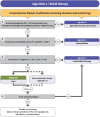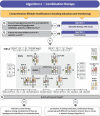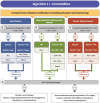2021 Clinical Practice Guidelines for Diabetes Mellitus of the Korean Diabetes Association
- PMID: 34352984
- PMCID: PMC8369224
- DOI: 10.4093/dmj.2021.0156
2021 Clinical Practice Guidelines for Diabetes Mellitus of the Korean Diabetes Association
Abstract
The Committee of Clinical Practice Guidelines of the Korean Diabetes Association (KDA) updated the previous clinical practice guidelines for Korean adults with diabetes and prediabetes and published the seventh edition in May 2021. We performed a comprehensive systematic review of recent clinical trials and evidence that could be applicable in real-world practice and suitable for the Korean population. The guideline is provided for all healthcare providers including physicians, diabetes experts, and certified diabetes educators across the country who manage patients with diabetes or the individuals at the risk of developing diabetes mellitus. The recommendations for screening diabetes and glucose-lowering agents have been revised and updated. New sections for continuous glucose monitoring, insulin pump use, and non-alcoholic fatty liver disease in patients with diabetes mellitus have been added. The KDA recommends active vaccination for coronavirus disease 2019 in patients with diabetes during the pandemic. An abridgement that contains practical information for patient education and systematic management in the clinic was published separately.
Keywords: Diabetes mellitus; Diagnosis; Practice guideline; Therapeutics.
Conflict of interest statement
No potential conflict of interest relevant to this article was reported.
Figures




References
-
- Korean Diabetes Association Treatment guideline for diabetes 6th ed. Available from: kdaguideline.com (cited 2021 Jul 16)
-
- American Diabetes Association 2. Classification and diagnosis of diabetes: standards of medical care in diabetes-2018. Diabetes Care. 2018;41(Suppl 1):S13–27. - PubMed
Publication types
MeSH terms
Substances
LinkOut - more resources
Full Text Sources
Medical

